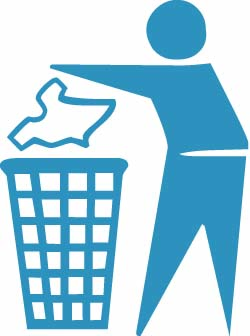Not everyone considers being called a “tree hugger” a compliment, but when we can do something for the environment and save money, well that’s something everyone can wrap their arms around. Like other states around the country, Indiana is faced with budget concerns at all levels of government. When budgets are tight, we look for ways to save money; and there are many cost-saving measures courts can employ that also happen to be eco-friendly.
In California, which is under severe budget constraints, state courts made changes to save money and realized that many of those changes also had a substantial environmental benefit. Monica Fiorentini, the supervising human resources analyst in the California Administrative Office of the Courts (AOC), recently published an article titled “Cost-Saving Measures Align with Green Initiatives” in Court Express.1 Some actions utilized by their courts that are both ecologically and economically friendly include: reducing travel by using conference calls; encouraging carpooling; and printing correspondence and written materials only when absolutely necessary.
Follow the Paper Trail
Remember when we thought that computers would reduce the amount of paper piled up in our offices? We find that it doesn’t always work that way. Before the Henry Circuit Court had an electronic docket, as in other courts across the state, court staff made hand-entries into the Chronological Case Summary (CCS). Even after Henry County installed its computerized system, they wanted to continue the handwritten entry practice so they programmed the system to print the entire CCS the day before a scheduled hearing. After the hearing the staff typed the summary of events into the computer and threw away the paper.
Henry County Circuit Court Judge Mary Willis realized how much paper—and money—was going into the trash every week, largely because of this practice. When Judge Willis faced the reality in October 2008 that her court would exceed its annual $1,275 budget for office supplies, she decided to discontinue the practice. “We were doing things a certain way because that’s how we had always done them,” she said. “So we needed to take a step back and think about how we could do things more efficiently and take advantage of the available technology.”

Today, the Circuit Court forgoes the printing of the CCS and instead uses a computer in the courtroom to key in entries directly. It has also implemented other paper-saving practices, including:
- Documents are formatted (reduce margins, text size, and space between lines) so they print out with fewer pages;
- Revisions are done entirely on the computer;
- Documents are double-sided when printed;
- Nothing is printed until it is final and ready for signature; and,
- The staff does not copy pro se packets but instead refers people to the self-service website (courts.IN.gov/selfservice).
Judge Willis estimates the Circuit Court has reduced its paper use by one ream every two weeks—which is nearly 13,000 sheets per year! As a result of these changes, the court is not only saving money on paper, but also saving money on printer cartridges.
Reduce, Reuse, Recycle
 The Division of State Court Administration is also making efforts to cut down the use of consumable products and to recycle what we do use. We take advantage of technology where we can to reduce printing, such as encouraging the emailing of scanned documents instead of receiving faxes. According to the Sierra Club, the average U.S. office worker goes through 10,000 sheets of copy paper a year.2 Even if we reduce the total amount we use, there will always be some amount of waste paper, so at the Division, we have two giant green bins in our workroom to recycle the used paper that once went into the trash.
The Division of State Court Administration is also making efforts to cut down the use of consumable products and to recycle what we do use. We take advantage of technology where we can to reduce printing, such as encouraging the emailing of scanned documents instead of receiving faxes. According to the Sierra Club, the average U.S. office worker goes through 10,000 sheets of copy paper a year.2 Even if we reduce the total amount we use, there will always be some amount of waste paper, so at the Division, we have two giant green bins in our workroom to recycle the used paper that once went into the trash.
Instead of buying bottled water, which just results in plastic bottle upon plastic bottle in need of recycling, we use a water purification system which delivers clean, fresh water straight to our glasses. We have also encouraged our landlord to institute a program for recycling cans and bottles, which they have yet to implement, and until they do many STAD employees take recyclables home or to their local recycling center.
Recycling doesn’t have to be just about paper, and it goes beyond sending our used goods to be pulped and reprocessed. In Henry County, the Circuit Court reuses paper clips and binder clips, and because one trash can is designated for organic waste, the rest of the waste baskets in the office only need their bags changed once per week. The court also takes used paper that has been printed only on one side to make notepads and scratch paper.
There are also other types of consumable products besides basic paper and plastics that are recyclable. Batteries are recyclable, and because of their toxicity do not belong in a dump among biodegradable material. We can also recycle printer cartridges and buy remanufactured cartridges. “Each remanufactured toner cartridge keeps about 2.5 pounds of metal and plastic out of landfills…and conserves about a half gallon of oil,” according to Office Depot.2
Evaluate Your Energy Use
Energy is a hot-button issue these days, whether we’re talking about conserving the natural resources that provide energy or the rising cost of driving our cars and heating and cooling our homes and offices. There are many ways to reduce energy consumption. According to the Sierra Club, artificial lighting accounts for 44 percent of the electricity used in office buildings, and computers in the business sector unnecessarily waste $1 billion worth of electricity per year!2
Think about turning off the lights in any room that isn’t being used and using natural light where available. Fluorescent bulbs require low wattage and should be used whenever possible. State Court Administration staff is encouraged to turn off lights when leaving offices and conference rooms, and LCD projectors are turned off when not in use. This not only conserves energy, it also extends the life of the projector bulbs, which cost hundreds of dollars each.
Who Doesn’t Want to Save Money?
 Judge Willis says it’s amazing how the simple steps they’ve taken have had such a huge impact on their budget and in reducing the amount of waste in the office. They didn’t start saving on paper until October, but they managed to make their budget last year. And it gets better, because her employees have taken the conservation mentality home with them and are applying the same principles around the house. “These are hard habits to break,” Judge Willis said, “but we know now they were bad habits.”
Judge Willis says it’s amazing how the simple steps they’ve taken have had such a huge impact on their budget and in reducing the amount of waste in the office. They didn’t start saving on paper until October, but they managed to make their budget last year. And it gets better, because her employees have taken the conservation mentality home with them and are applying the same principles around the house. “These are hard habits to break,” Judge Willis said, “but we know now they were bad habits.”
Courts around the state are certainly utilizing many of these and other methods already, and if your court has an idea to share, please let us know. If your court isn’t conserving, remember that Earth Day is April 22, so take some time to think about the easiest change your court can make and start there—regardless of whether you’re motivated by saving money or saving the planet.
Ways to Save Some Green
Reuse and Recycle
Recycle paper, aluminum cans, glass and plastic bottles, newspapers, CD-ROMs, and printer cartridges. Reuse paper clips, binder clips, waste bags, manila folders, binders; repurpose paper printed only on one side for scratch pads. And buy recycled products too!Eat and Drink
Stop providing bottled water or disposable cups. Instead, use glassware that can be washed and have employees bring their own mugs or cups for everyday use.Travel v. Telecommute
Limit your travel if possible; attend meetings via conference call or try a video chat or video conference solution. Also, encourage employees to carpool and make accommodations if necessary.Computer power and products
Turn off computers at night and the power strips they’re plugged into—otherwise they’re still drawing power. Stop wasting money on CD-ROMs or diskettes and buy a thumb drive to port documents from one computer to another.No Toxins
Use only non-toxic cleaning supplies to reduce fumes in your workspace.TELL US YOUR IDEAS
Share your best practices so we can share your money-saving ideas with the rest of the courts.Contact Brenda Rodeheffer at [email protected] or 317-234-3936.